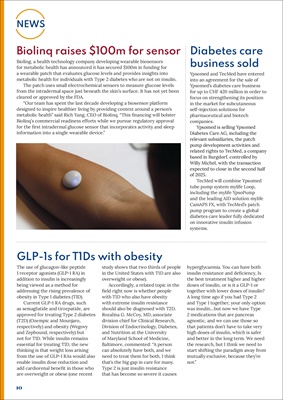
10
NEWS
If would like to take part, please contact the research team via
email: t1dstigmastudy@imperial.ac.uk or phone: 020 7594 5307
Biolinq raises $100m for sensor
Bioling, a health technology company developing wearable biosensors
for metabolic health has announced it has secured $100m in funding for
a wearable patch that evaluates glucose levels and provides insights into
metabolic health for individuals with Type 2 diabetes who are not on insulin.
The patch uses small electrochemical sensors to measure glucose levels from
the intradermal space just beneath the skin's surface. It has not yet been
cleared or approved by the FDA.
"Our team has spent the last decade developing a biosensor platform designed
to inspire healthier living by providing context around a person's metabolic
health" said Rich Yang, CEO of Biolinq. "This financing will bolster Biolinq's
commercial readiness efforts while we pursue regulatory approval for the first
intradermal glucose sensor that incorporates activity and sleep information
into a single wearable device."
GLP-1s for T1Ds with obesity
The use of glucagon-like peptide
1 receptor agonists (GLP-1 RA) in
addition to insulin is increasingly
being viewed as a method for
addressing the rising prevalence of
obesity in Type 1 diabetes (T1D).
Current GLP-1 RA drugs, such as
semaglutide and tirzepatide, are
approved for treating Type 2 diabetes
(T2D) (Ozempic and Mounjaro,
respectively) and obesity (Wegovy
and Zepbound, respectively) but
not for T1D. While insulin remains
essential for treating T1D, the new
thinking is that weight loss arising
from the use of GLP-1 RAs would also
enable insulin dose reduction and
add cardiorenal benefit in those who
are overweight or obese (one recent
study shows that two thirds of people
in the United States with T1D are also
overweight or obese).
Accordingly, a related topic in the
field right now is whether people
with T1D who also have obesity
with extreme insulin resistance
should also be diagnosed with T2D.
Rozalina G. McCoy, MD, associate
division chief for Clinical Research,
Division of Endocrinology, Diabetes,
and Nutrition at the University
of Maryland School of Medicine,
Baltimore, commented: "A person
can absolutely have both, and we
need to treat them for both. I think
that's the big gap in care for many.
Type 2 is just insulin resistance
that has become so severe it causes
hyperglycaemia. You can have both
insulin resistance and deficiency, Is
the best treatment higher and higher
doses of insulin, or is it a GLP-1 or
together with lower doses of insulin?
A long time ago if you had Type 2
and Type 1 together, your only option
was insulin…but now we have Type
2 medications that are pancreas
agnostic, and we can use those so
that patients don't have to take very
high doses of insulin, which is safer
and better in the long term. We need
the research, but I think we need to
start shifting the paradigm away from
mutually exclusive, because they're
not."
Diabetes care
business sold
Ypsomed and TecMed have entered
into an agreement for the sale of
Ypsomed's diabetes care business
for up to CHF 420 million in order to
focus on strengthening its position
in the market for subcutaneous
self-injection solutions for
pharmaceutical and biotech
companies.
Ypsomed is selling Ypsomed
Diabetes Care AG, including the
relevant subsidiaries, the patch
pump development activities and
related rights to TecMed, a company
based in Burgdorf, controlled by
Willy Michel, with the transaction
expected to close in the second half
of 2025.
TecMed will combine Ypsomed tube
pump system mylife Loop, including
the mylife YpsoPump and the leading
AID solution mylife CamAPS FX, with
TecMed's patch pump program to
create a global diabetes care leader
fully dedicated on innovative insulin
infusion systems.